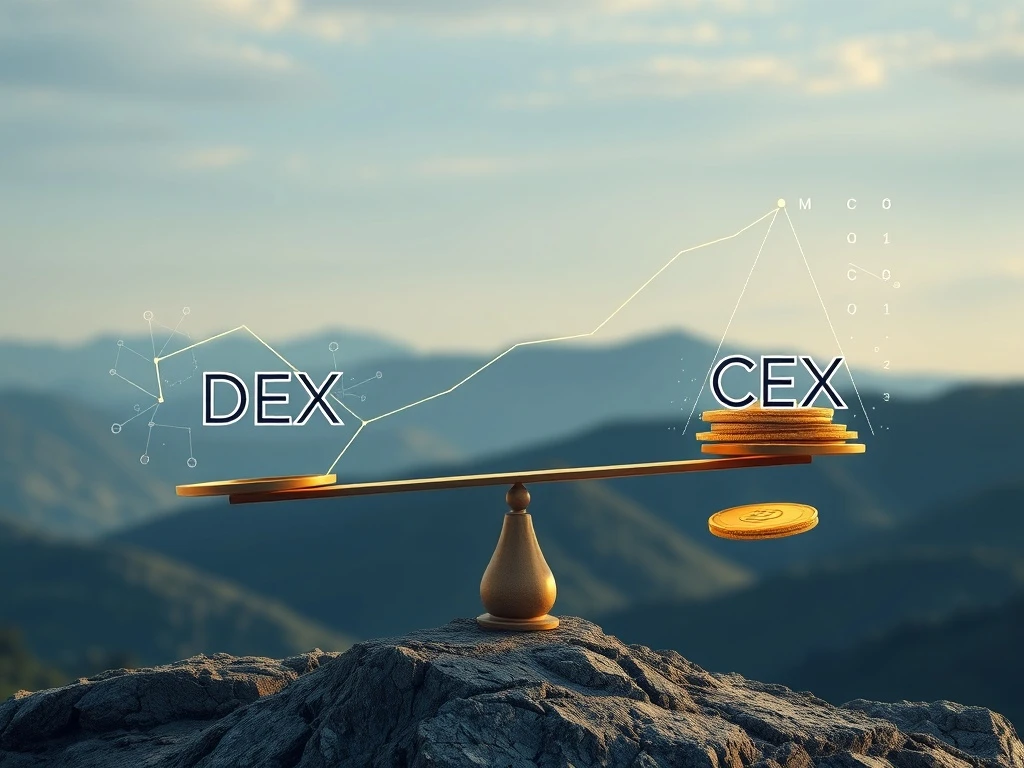DEX-to-CEX Ratio Soars: A Triumphant Shift for Decentralized Exchanges?

The cryptocurrency landscape is witnessing a significant evolution. A notable trend among crypto traders is a pronounced shift from centralized exchanges (CEXs) to decentralized alternatives (DEXs). This movement has pushed the DEX-to-CEX ratio to unprecedented levels, signaling a growing preference for self-custody and peer-to-peer trading environments.
Understanding the Shifting DEX-to-CEX Ratio
The latest industry reports reveal a compelling narrative: while centralized exchanges still dominate the overall crypto spot market in terms of raw volume, decentralized exchanges are rapidly gaining ground. The second quarter of 2025 saw spot trading volume on DEXs surge by at least 25% compared to the previous quarter. In stark contrast, CEX volumes experienced a nearly 28% decline during the same period. This dynamic shift propelled the DEX-to-CEX ratio from 0.13 in Q1 to a record high of 0.23 in Q2.
Despite this impressive growth, it’s crucial to acknowledge the scale difference. The top 10 decentralized trading platforms collectively posted $877 billion in volume in Q2, whereas CEXs commanded a substantial $3.9 trillion. This indicates that while the trend is clear, centralized platforms maintain a significant lead in overall market share for spot trading.
Why are Crypto Traders Embracing Decentralization?
Several factors contribute to the increasing adoption of decentralized exchanges:
- Enhanced Security and Control: DEXs operate on a non-custodial model, meaning users retain full control over their private keys and assets. This eliminates the risk of funds being frozen or lost due to exchange hacks, regulatory actions, or insolvency – a concern that has driven many users away from CEXs in recent times.
- Privacy and Anonymity: Most DEXs do not require Know Your Customer (KYC) verification, offering a greater degree of privacy to users. This appeals to individuals who prioritize anonymity in their financial transactions.
- Censorship Resistance: Being decentralized, these platforms are inherently more resistant to censorship and government intervention, aligning with the core ethos of cryptocurrency.
- Access to Emerging Assets: DEXs often list new tokens and projects earlier than CEXs, providing traders with opportunities to participate in nascent markets.
PancakeSwap Leads the Decentralized Charge
Within the rapidly expanding DEX ecosystem, one platform stands out: PancakeSwap. Built on the Binance Smart Chain (BSC), PancakeSwap emerged as the biggest gainer in Q2, with its volume skyrocketing by an astounding 539% to $392.6 billion, up from $61.4 billion in Q1. This monumental growth has positioned PancakeSwap as the largest DEX globally, capturing a dominant 45% of all decentralized trades in Q2.
CoinGecko attributes much of this surge to the launch of Binance Alpha in May, which strategically routes trades through PancakeSwap. This integration has not only bolstered PancakeSwap’s volume but also elevated BSC to become the most popular chain for DEX trading, surpassing established players like Ethereum, Base, and Solana. PancakeSwap’s success can be attributed to its user-friendly interface, lower transaction fees compared to Ethereum-based DEXs, and a wide array of DeFi services beyond simple spot trading.
The Explosive Growth of Perpetual Trading on DEXs
Beyond spot markets, decentralized crypto trading has achieved a major milestone in the realm of perpetual trading. These derivatives contracts allow traders to speculate on asset price movements without actually owning the underlying assets, offering high leverage and flexibility. In Q2, perpetual trading volume on DEXs reached an unprecedented all-time high of $898 billion, marking a significant moment in the evolution of decentralized finance.
Key players in this space include:
- Hyperliquid: This decentralized perpetual exchange, built on its own layer 1 blockchain, continues to solidify its dominance. It recorded an impressive $653 billion in trading volume, securing a commanding 73% market share among perp DEXs.
- Other Gainers: Aster (formerly APX Finance), RabbitX, and EdgeX also demonstrated significant volume growth within the top 10 perp DEXs.
- Shifting Tides: Notably, dYdX, once a prominent perp DEX, continued to see its volume decline, averaging $5.3 billion monthly compared to over $10 billion in January 2025. This highlights the dynamic and competitive nature of the decentralized derivatives market.
In contrast to the robust performance of decentralized derivatives, centralized alternatives experienced a slight 3.6% dip in derivatives trading quarter-over-quarter, further emphasizing the shift in trader preference for decentralized solutions in this high-stakes market segment.
What Does This Mean for the Future of Crypto Trading?
The escalating DEX-to-CEX ratio and the remarkable growth in decentralized spot and perpetual trading signal a maturing DeFi ecosystem. While centralized exchanges still offer unparalleled liquidity, fiat on-ramps, and institutional access, the benefits of decentralization — security, privacy, and censorship resistance — are increasingly resonating with a growing segment of crypto traders.
This trend suggests a future where both centralized and decentralized platforms coexist, catering to different user needs and preferences. However, the momentum clearly favors decentralization, pushing innovation in user experience, scalability, and liquidity solutions within the DEX space. As the technology evolves and user interfaces become more intuitive, decentralized exchanges are poised to capture an even larger share of the global crypto trading volume.
Conclusion: A Decentralized Dawn?
The latest data paints a clear picture: the crypto market is undergoing a fundamental shift. The surging DEX-to-CEX ratio, driven by the impressive growth of platforms like PancakeSwap and the record-breaking volumes in decentralized perpetual trading, underscores a growing confidence among crypto traders in the non-custodial and censorship-resistant nature of decentralized finance. While CEXs retain their market lead for now, the relentless innovation and increasing adoption of decentralized solutions suggest a future where the balance of power continues to shift, ushering in a more decentralized and user-empowered era of cryptocurrency trading.








